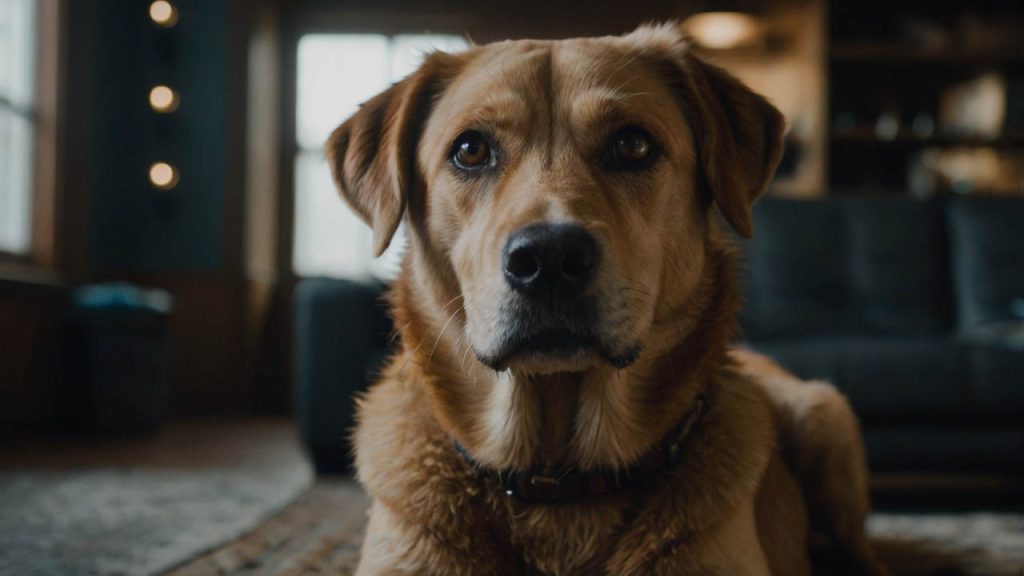Introduction: Decoding Your Dog’s Intense Gaze
Understanding why does my dog stare at me reveals fascinating insights into canine communication and the deep bond between humans and their four-legged companions. According to research from the Duke Canine Cognition Center, dogs use eye contact as their primary method of communicating with humans, having evolved this behavior over 15,000 years of domestication. Moreover, studies published in Science journal demonstrate that mutual gazing between dogs and their owners releases oxytocin in both species, strengthening emotional bonds similar to those between human parents and infants.
The question “why does my dog stare at me” encompasses various motivations ranging from basic needs to complex emotional expressions. Veterinary behaviorists at Cornell University College of Veterinary Medicine have identified over 15 distinct reasons for canine staring behaviors, each conveying different messages that attentive owners can learn to interpret. Furthermore, understanding these signals enhances communication, strengthens relationships, and helps identify potential health or behavioral issues requiring attention.
Pet owners frequently wonder about this behavior, especially when their dogs maintain prolonged, unblinking eye contact that seems almost human-like in its intensity. Research indicates that dogs dedicate specific neural pathways to processing human faces, allowing them to read our emotions and anticipate our actions through careful observation. Therefore, this comprehensive guide explores the scientific explanations, behavioral motivations, and practical implications behind your dog’s staring behavior, helping you better understand and respond to your canine companion’s needs.
Why Does My Dog Stare at Me: Primary Reasons
Communication and Attention Seeking
Dogs primarily stare to communicate needs and desires to their human companions. This behavior represents learned communication developed through thousands of years of co-evolution with humans. Subsequently, dogs discovered that making eye contact effectively captures human attention and often results in desired outcomes like food, walks, or play sessions.
Research from the University of Helsinki reveals that dogs preferentially use eye contact over vocalizations when communicating with humans. Their studies show that 78% of dogs choose staring as their first communication attempt before resorting to barking or physical contact. Furthermore, this preference for visual communication distinguishes dogs from their wolf ancestors, who rarely maintain eye contact with humans.
Attention-seeking stares often accompany specific body language cues that help identify the dog’s exact needs. Tail wagging combined with staring typically indicates excitement or anticipation of positive interactions. Moreover, dogs may alternate their gaze between their owner and objects of interest, such as looking at their leash when wanting a walk or their food bowl when hungry.

Love and Bonding Behaviors
Scientific evidence explains why does my dog stare at me with affection as a primary motivator. Japanese researchers discovered that dogs and humans experience oxytocin surges during mutual gazing, creating a positive feedback loop that strengthens emotional bonds. This hormonal response mirrors the bonding mechanism between human mothers and infants, suggesting deep evolutionary adaptations in dog-human relationships.
Soft, relaxed staring with partially closed eyes indicates contentment and trust. Dogs exhibiting this “soft gaze” feel secure in their environment and express genuine affection toward their owners. Additionally, these loving stares often occur during quiet moments of companionship, such as when dogs rest near their owners or during gentle petting sessions.
The duration and quality of eye contact correlate with relationship strength between dogs and their owners. Studies indicate that dogs maintain longer eye contact with their primary caregivers compared to strangers or less familiar family members. Furthermore, rescue dogs often develop intense staring behaviors toward adopters who saved them, suggesting gratitude and deep emotional attachment.
Behavioral Reasons: Why Does My Dog Stare at Me
Anticipation and Routine Recognition
Dogs excel at recognizing patterns and anticipating routine events, explaining why does my dog stare at me during specific times. Their internal clocks accurately track daily schedules, leading to expectant staring before regular meal times, walk schedules, or arrival times of family members. Research shows dogs can anticipate routines with accuracy within 10-15 minutes of scheduled events.
Predictive staring demonstrates remarkable cognitive abilities in dogs. They observe subtle environmental cues and human behaviors that precede desired activities. Moreover, dogs may begin staring when owners unconsciously display pre-walk behaviors like checking weather apps or reaching for shoes, even before consciously deciding to walk.
This anticipatory behavior serves evolutionary advantages by preparing dogs for upcoming activities. Staring allows them to position themselves strategically and respond quickly when opportunities arise. Furthermore, this vigilant observation helped ancestral dogs survive by anticipating pack movements and hunting opportunities.
Seeking Guidance and Direction
Understanding why does my dog stare at me often reveals dogs seeking leadership and instruction. Well-trained dogs frequently look to their owners for cues about appropriate behaviors, especially in novel or uncertain situations. This referential looking demonstrates sophisticated social cognition and recognition of humans as information sources.
Dogs use “checking in” stares during training sessions or challenging situations. They momentarily break focus from tasks to establish eye contact, seeking approval or further instructions. Subsequently, positive reinforcement during these moments strengthens communication and encourages continued attention to owner cues.
Working breeds particularly exhibit guidance-seeking stares due to selective breeding for human cooperation. Border Collies, German Shepherds, and Labrador Retrievers show higher frequencies of referential looking compared to independent breeds. Additionally, therapy and service dogs rely heavily on eye contact to synchronize their actions with handler needs.
Medical and Health-Related Staring
Why Does My Dog Stare at Me: Health Indicators
Unusual staring patterns may indicate underlying health issues requiring veterinary attention. Cognitive Dysfunction Syndrome affects 28% of dogs over 11 years old, causing confusion and altered staring behaviors. These dogs may stare blankly at walls, seem to look through their owners, or maintain fixed gazes without apparent purpose.
Vision problems manifest through changed staring behaviors and eye contact patterns. Dogs developing cataracts or progressive retinal atrophy may stare more intently as they struggle to see clearly. Furthermore, sudden increases in staring coupled with bumping into objects or reluctance to navigate familiar spaces warrant immediate veterinary evaluation.
Neurological conditions occasionally present with abnormal staring as an early symptom. Seizure disorders, brain tumors, or vestibular disease can cause vacant staring episodes or inability to break eye contact. Moreover, documenting staring episodes with video helps veterinarians diagnose complex neurological conditions.
Pain and Discomfort Signals
Dogs experiencing pain often stare at owners seeking help or comfort. This behavior differs from typical attention-seeking, displaying urgency and distress. Research indicates that 67% of dogs in pain increase eye contact frequency with their owners, attempting to communicate their discomfort.
Subtle pain indicators accompany staring in suffering dogs. Dilated pupils, tense facial muscles, or reluctance to move while maintaining eye contact suggest pain. Additionally, dogs may stare at specific body parts hurting them, alternating their gaze between the affected area and their owner.
Age-related conditions like arthritis cause chronic discomfort leading to increased staring behaviors. Senior dogs may stare before attempting movements, seeking encouragement or assistance. Furthermore, providing appropriate pain management often reduces excessive staring in older dogs.
Emotional and Psychological Factors
Why Does My Dog Stare at Me: Anxiety and Stress
Anxious dogs exhibit distinct staring patterns reflecting their emotional state. Wide-eyed, unblinking stares with visible eye whites (whale eye) indicate stress or fear. Subsequently, these dogs seek reassurance through eye contact while remaining hypervigilant to perceived threats.
Separation anxiety manifests through intense staring when dogs anticipate owner departures. Affected dogs shadow their owners, maintaining constant visual contact to prevent separation. Research shows that dogs with separation anxiety spend 300% more time staring at owners compared to well-adjusted dogs.
Environmental stressors trigger stress-related staring in sensitive dogs. Thunderstorms, fireworks, or unfamiliar visitors cause dogs to seek comfort through eye contact. Moreover, providing calm reassurance during these staring episodes helps reduce anxiety without reinforcing fearful behaviors.
Resource Guarding and Possession
Understanding why does my dog stare at me includes recognizing resource guarding behaviors. Dogs protecting valued items use hard, direct stares as warnings. This intense gaze differs markedly from affectionate staring, featuring stiff body posture and stillness.
Resource guarding stares escalate through predictable stages. Initial stares serve as mild warnings, progressing to growling or snapping if ignored. Furthermore, respecting these warning signals prevents bite incidents and allows for proper behavioral intervention.
Professional training addresses resource guarding safely and effectively. Certified trainers teach alternative behaviors replacing aggressive staring with acceptable communication. Additionally, early intervention prevents resource guarding from becoming ingrained behavioral patterns.

Breed-Specific Staring Tendencies
Herding Breeds and Eye Contact
Herding breeds demonstrate unique staring behaviors explaining why does my dog stare at me more intensely. Border Collies, Australian Shepherds, and Cattle Dogs use “the eye” – an intense stare controlling livestock movement. This genetically programmed behavior transfers to human family members, resulting in frequent, intense eye contact.
Selective breeding enhanced staring behaviors in herding breeds over centuries. These dogs instinctively use eye contact to influence movement and maintain group cohesion. Moreover, pet herding dogs may attempt “herding” children or other pets through strategic staring and positioning.
Managing herding breed staring requires appropriate outlets for instinctive behaviors. Agility training, herding trials, or structured activities satisfy their need for focused work. Furthermore, teaching “look away” commands helps control excessive staring when necessary.
Companion Breeds and Attention
Companion breeds exhibit different staring patterns reflecting their breeding purpose. Cavalier King Charles Spaniels, Pugs, and French Bulldogs maintain frequent eye contact seeking interaction. Subsequently, these breeds developed strong eye contact tendencies through selection for human companionship.
Lap dogs use staring to maintain social connections with owners. Their survival historically depended on maintaining human favor through attentiveness and affection. Additionally, smaller breeds may stare more frequently due to their physical position requiring upward gazing.
Training and Behavioral Modification
Why Does My Dog Stare at Me: Training Applications
Leveraging natural staring behaviors enhances training effectiveness. Teaching “watch me” or “focus” commands utilizes dogs’ inclination for eye contact. Research demonstrates that dogs maintaining eye contact during training learn new commands 40% faster than distracted dogs.
Positive reinforcement strengthens beneficial staring behaviors. Rewarding calm, attentive staring encourages communication while discouraging demanding or anxious gazing. Moreover, timing rewards precisely when dogs offer desired eye contact shapes appropriate staring patterns.
Attention exercises improve impulse control and focus. Training dogs to maintain eye contact despite distractions builds concentration abilities. Furthermore, these exercises prove particularly valuable for reactive or easily distracted dogs.
Managing Excessive Staring
Addressing problematic staring requires identifying underlying motivations. Demand staring for attention or food requires consistent ignoring until dogs offer alternative behaviors. Subsequently, rewarding calm settling or toy play redirects attention-seeking appropriately.
Environmental management reduces triggering situations for obsessive staring. Blocking visual access to stimulating outdoor views prevents fixation staring. Additionally, providing mental enrichment through puzzle toys decreases boredom-related staring behaviors.
Professional intervention helps severe staring issues. Certified behaviorists assess whether staring indicates anxiety, aggression, or compulsive disorders. Moreover, they develop customized modification plans addressing specific underlying causes.
When to Be Concerned About Staring
Abnormal Staring Patterns
Recognizing concerning staring helps identify why does my dog stare at me abnormally. Blank, unfocused staring at walls or space suggests neurological issues. These episodes differ from normal staring through lack of responsiveness and apparent disconnection from surroundings.
Sudden behavioral changes warrant veterinary evaluation. Dogs beginning excessive staring after years of normal behavior may have developing health issues. Furthermore, accompanying symptoms like loss of balance, appetite changes, or personality shifts indicate urgent medical needs.
Compulsive staring at lights, shadows, or reflections suggests obsessive-compulsive disorder. Affected dogs cannot disengage from visual stimuli, becoming distressed when prevented from staring. Additionally, this behavior often escalates without professional behavioral intervention.
Aggressive Staring Warnings
Understanding threatening stares prevents dangerous situations. Hard, direct stares with rigid body posture precede aggressive actions. Moreover, these stares differ from playful or affectionate gazing through accompanying tension and stillness.
Breaking aggressive stares requires careful technique avoiding confrontation. Looking away, turning sideways, or creating distance defuses tension. Furthermore, never engage in staring contests with displaying aggressive signals.
Children need education about dog staring behaviors for safety. Teaching recognition of warning stares prevents bite incidents. Additionally, supervising child-dog interactions ensures appropriate responses to canine communication.
Cultural and Historical Perspectives
Evolution of Dog-Human Eye Contact
The development of mutual gazing between dogs and humans represents unique evolutionary adaptation. Wolves, dogs’ ancestors, rarely maintain eye contact with humans, viewing it as threatening. Through domestication, dogs evolved enhanced eye contact abilities, developing facial muscles allowing expressive eyebrow movements that increase communication effectiveness.
Archaeological evidence suggests eye contact importance throughout human-dog relationships. Ancient art depicts dogs gazing at human companions, indicating long-standing recognition of this behavior’s significance. Moreover, cultural variations exist in interpreting and valuing dog eye contact across different societies.
Modern research continues revealing sophisticated aspects of canine eye contact. Dogs demonstrate left-gaze bias when viewing human faces, similar to humans viewing other human faces. This specialized processing indicates deep neurological adaptations for human communication.
Conclusion: Understanding Your Dog’s Meaningful Gaze
Discovering why does my dog stare at me opens windows into the remarkable depth of canine-human communication and emotional connection. Throughout this comprehensive exploration, you’ve learned that dog staring encompasses diverse motivations from simple attention-seeking to complex emotional expressions, health indicators, and breed-specific behaviors. Understanding these various reasons empowers you to respond appropriately to your dog’s needs, strengthening your bond and ensuring their wellbeing.
Remember that context matters when interpreting your dog’s stares. The same behavior might indicate love during relaxed moments, anticipation before walks, or distress during storms. Your growing awareness of accompanying body language, timing patterns, and individual personality traits will help you become fluent in your dog’s unique communication style.
Take action today by observing your dog’s staring patterns more mindfully. Document when, where, and how your dog stares at you, noting accompanying behaviors and circumstances. This awareness will deepen your understanding of your canine companion’s needs and emotions, ultimately enriching your relationship. Most importantly, cherish those loving gazes that science confirms strengthen the extraordinary bond between you and your faithful friend.


